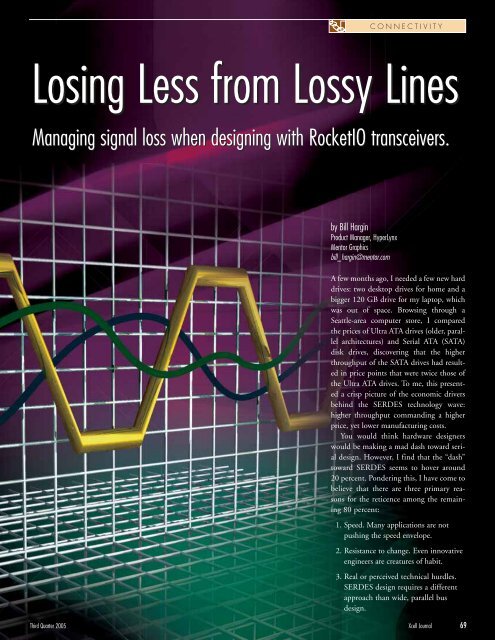Design Challenges: Avoiding the Pitfalls, winning the game - Xilinx
Design Challenges: Avoiding the Pitfalls, winning the game - Xilinx
Design Challenges: Avoiding the Pitfalls, winning the game - Xilinx
Create successful ePaper yourself
Turn your PDF publications into a flip-book with our unique Google optimized e-Paper software.
y Bill Hargin<br />
Product Manager, HyperLynx<br />
Mentor Graphics<br />
bill_hargin@mentor.com<br />
CONNECTIVITY<br />
Losing Less from Lossy Lines<br />
Managing signal loss when designing with RocketIO transceivers.<br />
A few months ago, I needed a few new hard<br />
drives: two desktop drives for home and a<br />
bigger 120 GB drive for my laptop, which<br />
was out of space. Browsing through a<br />
Seattle-area computer store, I compared<br />
<strong>the</strong> prices of Ultra ATA drives (older, parallel<br />
architectures) and Serial ATA (SATA)<br />
disk drives, discovering that <strong>the</strong> higher<br />
throughput of <strong>the</strong> SATA drives had resulted<br />
in price points that were twice those of<br />
<strong>the</strong> Ultra ATA drives. To me, this presented<br />
a crisp picture of <strong>the</strong> economic drivers<br />
behind <strong>the</strong> SERDES technology wave:<br />
higher throughput commanding a higher<br />
price, yet lower manufacturing costs.<br />
You would think hardware designers<br />
would be making a mad dash toward serial<br />
design. However, I find that <strong>the</strong> “dash”<br />
toward SERDES seems to hover around<br />
20 percent. Pondering this, I have come to<br />
believe that <strong>the</strong>re are three primary reasons<br />
for <strong>the</strong> reticence among <strong>the</strong> remaining<br />
80 percent:<br />
1. Speed. Many applications are not<br />
pushing <strong>the</strong> speed envelope.<br />
2. Resistance to change. Even innovative<br />
engineers are creatures of habit.<br />
3. Real or perceived technical hurdles.<br />
SERDES design requires a different<br />
approach than wide, parallel bus<br />
design.<br />
Third Quarter 2005 Xcell Journal 69

















